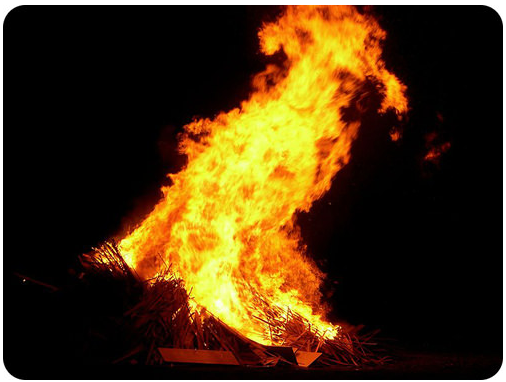Are All Exothermic Reactions Spontaneous
20.3: Spontaneous and Nonspontaneous Reactions
- Folio ID
- 53923
Nitroglycerin is a tricky substance. An active ingredient in dynamite (where it is stabilized), "raw" nitroglycerin is very unstable. Concrete shock will crusade the material to explode. The reaction is shown below.
\[four \ce{C_3H_5(ONO_2)_3} \rightarrow 12 \ce{CO_2} + ten \ce{H_2O} + 6 \ce{N_2} + \ce{O_2}\nonumber \]
The explosion of nitroglycerin releases large volumes of gases and is very exothermic.
Spontaneous Reactions
Reactions are favorable when they issue in a decrease in enthalpy and an increment in entropy of the organization. When both of these conditions are met, the reaction occurs naturally. A spontaneous reaction is a reaction that favors the formation of products at the weather nether which the reaction is occurring. A roaring bonfire is an example of a spontaneous reaction, since information technology is exothermic (there is a decrease in the energy of the system as energy is released to the surroundings as estrus). The products of a fire are composed partly of gases such as carbon dioxide and h2o vapor. The entropy of the organization increases during a combustion reaction. The combination of energy decrease and entropy increase dictates that combustion reactions are spontaneous reactions.

A nonspontaneous reaction is a reaction that does not favor the formation of products at the given gear up of weather. In gild for a reaction to be nonspontaneous, it must be endothermic, accompanied by a subtract in entropy, or both. Our atmosphere is composed primarily of a mixture of nitrogen and oxygen gases. Ane could write an equation showing these gases undergoing a chemic reaction to course nitrogen monoxide:
\[\ce{N_2} \left( g \correct) + \ce{O_2} \left( g \right) \rightarrow 2 \ce{NO} \left( m \right)\nonumber \]
Fortunately, this reaction is nonspontaneous at normal temperatures and pressures. It is a highly endothermic reaction with a slightly positive entropy change \(\left( \Delta S \correct)\). Nitrogen monoxide is capable of being produced at very high temperatures and has been observed to form every bit a upshot of lightning strikes.
One must exist careful not to confuse the term spontaneous with the notion that a reaction occurs quickly. A spontaneous reaction is one in which product formation is favored, even if the reaction is extremely slow. A slice of paper will not of a sudden outburst into flames, although its combustion is a spontaneous reaction. What is missing is the required activation energy to get the reaction started. If the paper were to be heated to a high enough temperature, information technology would begin to burn down, at which signal the reaction would proceed spontaneously until completion.
In a reversible reaction, one reaction management may be favored over the other. Carbonic acid is present in carbonated beverages. It decomposes spontaneously to carbon dioxide and h2o, according to the post-obit reaction.
\[\ce{H_2CO_3} \left( aq \correct) \rightleftharpoons \ce{CO_2} \left( 1000 \right) + \ce{H_2O} \left( l \correct)\nonumber \]
If you were to start with pure carbonic acid in water and allow the system to come to equilibrium, more than \(99\%\) of the carbonic acrid would exist converted into carbon dioxide and h2o. The forward reaction is spontaneous considering the products of the forrad reaction are favored at equilibrium. In the contrary reaction, carbon dioxide and water are the reactants, and carbonic acrid is the production. When carbon dioxide is bubbled into water, less than \(1\%\) is converted to carbonic acid when the reaction reaches equilibrium. The reverse reaction, as written in a higher place, is non spontaneous.
Summary
- Spontaneous and nonspontaneous reactions are divers.
- Examples of both types of reactions are given.
Are All Exothermic Reactions Spontaneous,
Source: https://chem.libretexts.org/Bookshelves/Introductory_Chemistry/Introductory_Chemistry_(CK-12)/20%3A_Entropy_and_Free_Energy/20.03%3A_Spontaneous_and_Nonspontaneous_Reactions
Posted by: cannonothympas.blogspot.com


0 Response to "Are All Exothermic Reactions Spontaneous"
Post a Comment